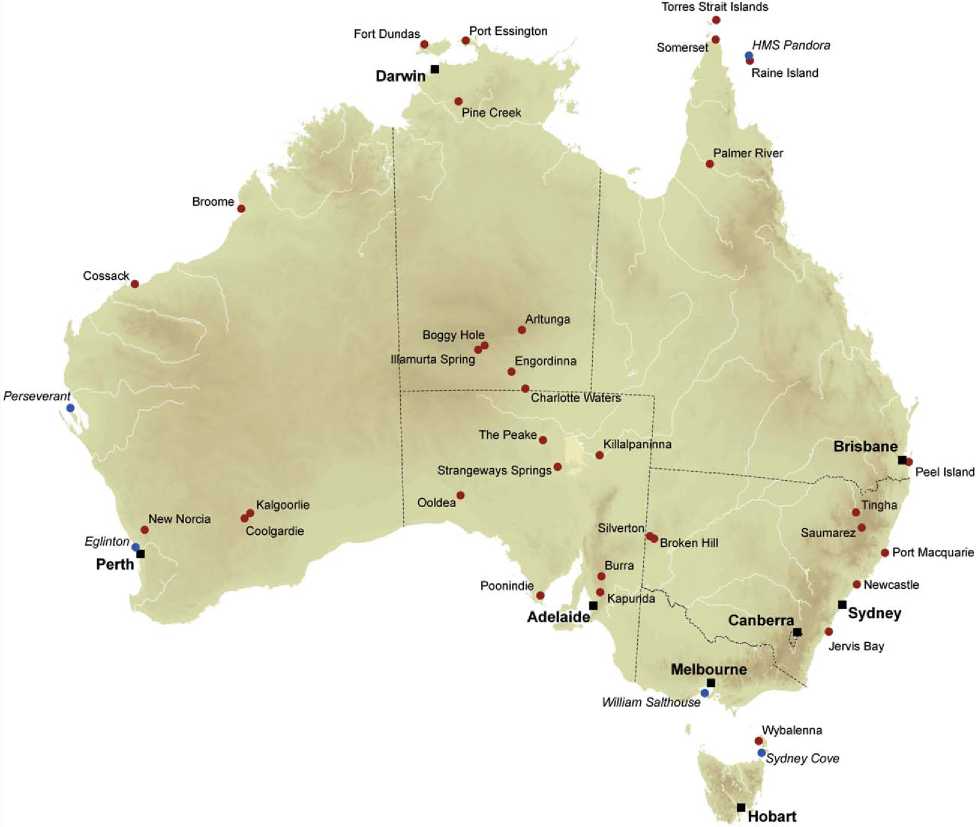Australian urban excavation rarely presents Old World depth and complexity, but still has more superimposed structural and occupation layers than the majority of sites in rural and remote Australia. Such excavation since the 1970s is development driven under heritage legislation, so that in general, time frames are tight and site boundaries prescribed by development rather than research priorities. Finance is not always sufficient to cover the processing, publishing, and storage of finds, and the site-specific nature of these investigations does little to support inter-site comparison and analysis.
Fuelled by growing public concern, rescue archeology had a lively start in 1974, when a very early burial, disturbed during construction of Sydney’s Town Hall Square was immediately excavated by Sydney University’s new Historical Archaeology students. Regulations for rescue excavation followed the extensive heritage survey and assessments of government-owned assets throughout Australia - including hospitals, asylums, jails, and naval and defense establishments in several Australian cities - which were required by Commonwealth legislation of 1975, a huge task involving many historical archaeologists over the next decade and more.
From 1975 into the 1980s, historical archaeology accelerated in the Sydney CBD under State legislation, with excavation in advance of development at the important sites of Hyde Park Convict Barracks, the historic Sydney Hospital, Old Sydney Gaol, and the Colony’s First Government House by 1984, followed in the later 1980s by The Australian Gaslight Co. site, and excavations in the Haymarket, Paddy’s Market, Darling Harbor, and CSR-Pyrmont, as well as increasing excavation of historic Parramatta. Earlier rescue projects primarily involved public buildings and accessed well-ordered government records: now excavators were using municipal residence records to structure comparative analyses of working-class households. Heritage legislation in other states followed during the 1980s, with the Little Lonsdale project (1987-88) and City Link (1989) in Melbourne.
In 1988, the Seventh Annual ASHA Conference - Archaeology in the World Context - discussed the implications of this expanding body of nineteenth and twentieth century archaeological data in a more international context, reviewing current approaches to the analysis of urban rubbish fills, whether underfloor, well, or privy fills or yard rubbish derived from single households or successive occupancies. In 1994, Sydney’s important Cumberland St. excavations used a combination of finds and municipal records to explore the nature of the households revealed. Dietary remains as well as selection and quality of household goods suggested how rapidly former convicts seemed to have climbed the social ladder. Conversely, street and yard assemblages add rich archaeological data on low-efficiency sewage and water systems, and street butchering and vegetable refuse. A La Trobe University project, Exploring the Archaeology of the Modern City, later developed the 1988 conference themes by revisiting slum-land stereotypes in both Melbourne and Sydney.
Other recent work on the Rocks has set the Chinese presence there in a wider context. Analyses of shipwreck cargoes now include new emphasis on urban consumer preferences, as well as intercolonial ceramic and other trade networks (Figure 1). Another archaeological focus has been mapping early Sydney archaeologically in relation to historic sources. To date such early sites include the Brickfields Hill brick and pottery-making sites, the first burial ground, the earliest jail, the first Observatory, earliest defenses, stretches of the original shoreline, and the foundations of the first Government House.
In fact, since the boundaries of city sites are constrained by development needs rather than research questions, archaeologists are left to make the best of what they uncover. One solution is archaeological forward planning with the incorporation of potential city sites (and prepared research questions) into the

Figure 1 Historical archaeological and shipwreck sites in Australia referred to in the text. Map by Andrew Wilson, Archaeological Computing Laboratory, University of Sydney.
Planning process instead of repetitive reaction to one-off excavations. Such a policy is now in place for Parramatta, the second town laid out in the Colony by Governor Phillip in 1789, which is undergoing major redevelopment. Five huts have been excavated here since 1985.The historic plan is known so that projections can be made about excavation potential into a preformulated integrated program with consistent themes, from the initial convict huts through all phases of its later development.
Access to archaeological results can still be a problem, with completed reports - as required by excavation permits - mostly stored in State heritage libraries. Urban excavations often offer public participation in the dig, as well as Open Day visitation, and recommend conservation of significant remains.
A few become museums like the Museum of Sydney (on the site of First Government House), Hyde Park Barracks museum, or the Rocks Discovery Centre in Sydney. Many excavation sites are now commemorated by interpretive displays: variations on the Sydney Time Map which leads from site to artifact to people and back have proved promising.
Other information is to be found in archaeological newsletters, web sites, and journal articles, and there are a number of monograph series and books. However, publication of the excavations themselves is often delayed where archaeological assemblages are ill-defined, historical records poor, and/or quantities of uninformative finds large. Recent overview publications of history and archaeology on the Rocks sites are a welcome development.




 World History
World History









